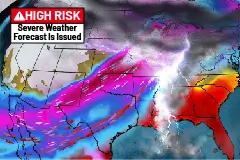Don't Be a Victim, Try these Useful Tips to Survive in Tornado!
Can you Imagine that the United States experiences an average of 1,200 tornadoes each year? The number is horrifying and preparations are a must. As of December 27, 2024, there have already been 1,783 tornado reports, surpassing the annual average. Tornadoes, often unpredictable and devastating, demand preparedness. Just this past Saturday, December 28, tornado-spawning storms wreaked havoc across Texas and Mississippi, claiming at least four lives and leaving a trail of destruction. In Brazoria County, Texas, one person died, while four others sustained injuries. In Natchez, Mississippi, a high school student tragically lost their life when a tree fell on their home.

Nearly seven million Americans are currently under tornado watches, with the National Weather Service issuing rare "particularly dangerous situation" alerts, warning of EF2-strength or stronger tornadoes. It’s clear that the threat of tornadoes is far from over. Let’s discuss practical survival tips to keep you and your loved ones safe during these perilous events.
What You Need to Know About Tornadoes?
Tornadoes are not just spinning winds—they’re nature’s most violent storms, capable of leveling entire towns in minutes. Winds can exceed 300 mph, and their unpredictability is what makes them so dangerous.
Why Tornadoes Form?
When warm, moist air from the south collides with cold, dry air from the north, instability forms in the atmosphere. Add wind shear (changes in wind direction and speed with altitude), and boom, there’s tornadoes.
Where and When Do They Strike?
While "Tornado Alley" in the U.S. (think Texas, Kansas, Oklahoma) is notorious, don’t overlook other hotspots:
- Argentina & Uruguay: Known as the “Southern Cone,” this region sees violent storms.
- Bangladesh: Tornadoes here, though less frequent, are deadly due to high population density.
- South Africa: Tornadoes are rare but can cause significant damage.
In the U.S., peak tornado season is April to June, but these storms can happen year-round. Just like what happened lately around, a mom is carrying her terrified daughter. Tornadoes would occur all year round, that’s why we always need to be attention.
Hidden Dangers Tornadoes Bring that You Need to Be Careful
Tornadoes don’t just destroy—they leave lasting effects.
- Flying Debris: Most injuries and fatalities occur from debris traveling at high speeds.
- Respiratory Risks: Dust and debris in the air can trigger asthma or breathing issues.
- Infrastructure Damage: Power outages and road blockages can leave communities stranded.
Preparation is Everything: How to Stay Safe?
1. Where to Go When a Tornado Hits?
- Best Bet: A basement or storm shelter.
- No Basement? Use an interior room on the lowest floor without windows, like a bathroom or closet.
I’ll never forget one time when I hunkered down in my hallway with a mattress over my head—it wasn’t comfortable, but it worked! Better Keep up with lately forecast and alert, prepare and stay in a safe place until the tornado’s gone.
2. Emergency Kit Must-Haves Your tornado survival kit should include:
- Water (at least one gallon per person per day).
- Non-perishable food.
- First aid supplies. Sturdy shoes (you’ll thank me later).
- A whistle for signaling if you’re trapped.
Pro Tip: Toss in dust masks to protect your lungs from debris.
3. Tornado Alerts: Stay Ahead of the Storm
Know the difference between a watch (conditions are favorable) and a warning (a tornado is imminent or spotted). Apps like Weather Underground and NOAA Weather Radar have given me crucial alerts more than once—don’t underestimate them!
Protecting Your Home
Now, let’s talk about fortifying your home. It’s one of the best ways to shield yourself and your loved ones from harm.
1. Tornado-Resistant Features
Think your home is safe enough? Tornadoes test every single inch of your house. So, reinforcing doors, windows, and roofs with materials like steel or concrete can make total difference. Adding storm shutters or impact-resistant windows not only boosts safety but can also reduce energy costs year-round. And if you’re considering it, building a storm shelter might feel like a big investment now, but what’s peace of mind worth when a storm is bearing down?
2. Smart Landscaping
Your yard is your first line of defense. It's important while easy to ignore. Remember to trim your trees— beacuase weak branches can become dangerous. Keep outdoor furniture secure and clear away any loose debris. Wondering if it’s worth the effort? I will tell you my experience, once I ignored a wobbly lawn chair, and guess what—it smashed my shed window during a storm. Lesson learned!
3. Stay Connected With Your Family Members
How will you stay in touch if phone lines go down? Tornadoes might dispower the whole electricity supply. Knowing your local shelter locations and sharing your family’s emergency plan are essential. Use group texts or emergency apps to keep everyone updated. Communication might seem like a small detail now, but in a crisis, it’s everything.
After the Storm
When the skies clear, the danger isn’t completely gone. What’s your next move? Acting quickly but cautiously can make all the difference.
- Inspect Your Property: Before stepping inside, check for gas leaks, structural damage, and downed power lines. Safety first!
- Health First: Inhaled debris or unnoticed injuries can become serious—seek medical attention promptly.
- Document Damage: Snap photos and videos for insurance claims. This small step can save you a lot of stress later.
The Takeaway
Tornadoes may be unstoppable, but their impact on your life doesn’t have to be catastrophic. By preparing your home, staying informed, and knowing where to go when danger strikes, you can protect your loved ones and emerge stronger.
I’ve seen how preparation can make all the difference—now it’s your turn to act quickly to save you and your loved ones lives. Take these steps today and share them with your friends. Let’s weather the storm together!


